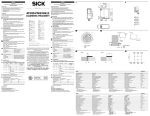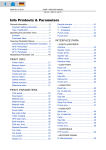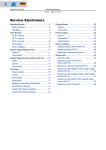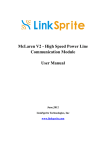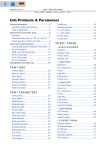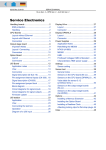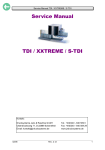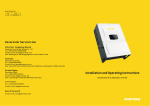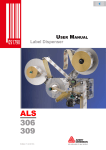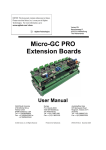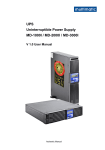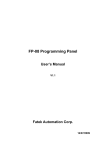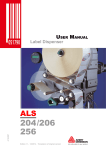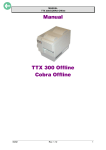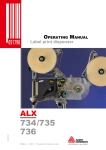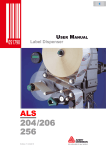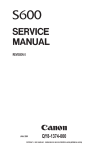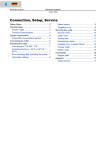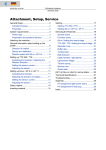Download Service Electronics
Transcript
04/10 Rev. 5.05-00 SERVICE MANUAL AP 5.4 – AP 5.6 Service Electronics Handling Boards ........................................... 2 ESD protection .......................................... 2 Handling .................................................... 2 CPU board .................................................... 3 Connections .............................................. 3 Interfaces .................................................. 5 Sensor connections ................................... 6 Lithium Battery .......................................... 7 Output stage board for stepper motor ........... 9 Connections, settings ................................ 9 Output stage board for brushless motor ..... 10 Notes ....................................................... 10 Connections, settings .............................. 11 I/O-board ..................................................... 12 Connections, settings .............................. 12 Application ............................................... 12 Pin assignment serial interface ............... 13 Pin assignment signal interface .............. 15 Setting the Interface Parameters ............ 17 Circuit diagrams for signal inputs ............ 18 Circuit diagrams for signal outputs .......... 19 Testing the Signal Interface .................... 21 Operation panel ...........................................22 Connections .............................................22 Power supply ...............................................23 Connections .............................................23 Specifications ...........................................24 Interface for peripheral devices ...................25 Sensor settings ............................................26 Setting sensors ........................................26 Setting the material end sensor ...............30 Sensor test ..................................................31 General notes ..........................................31 Sensors on the CPU board ......................32 Sensors on the stepper motor output stage board .......................................................33 Sensors on the BLDC motor output stage board .......................................................33 Sensors on the I/O board: ........................34 2 04/10 Rev. 5.05-00 SERVICE MANUAL Service Electronics AP 5.4 – AP 5.6 Handling Boards ESD protection CAUTION! - The boards can be destroyed by static discharge! « Before opening the printer, place it on a grounded surface. « Earth your body using an ESD bracelet or other suitable means, before touching a board. If no suitable ESD protection is available, touch an earthed object, e.g. a heating radiator, before touching a board. « Only place boards on earthed surfaces. Handling CAUTION! - The conducting tracks on the boards are very thin. If a board is bent or warped, the conducting tracks can easily crack. « Avoid bending or warping boards. « Avoid the use of excessive force when removing or inserting boards. 3 04/10 Rev. 5.05-00 SERVICE MANUAL Service Electronics AP 5.4 – AP 5.6 CPU board Connections AD A AE AF B AC C AB AA D Z E F G H I J Y X K W L V M U N O T P S [1] CPU board connections (A100150). R Q 4 04/10 Rev. 5.05-00 SERVICE MANUAL Service Electronics AP 5.4 – AP 5.6 • CNxxxx = Connector • Dxxxx = LED • JPxxx = Jumper A CN1201: Power supply B CN601: Feed motor C CN1202: D-Sub harness, marking „POWER“ D CN501: I/O-board (option) E CN1001: printhead F CN602: Motor output stage board(s); Data line G CN702: Operation panel H CN701: External operation panel I CN801: I2C bus J CN904: Not applied K CN905: Label sensor (transmissive) L CN906: Ribbon end sensor M CN907: Locking lever sensor N CN908: Label sensor (reflex bottom) O CN909: Label sensor (reflex top) P CN910: D-Sub harness, marking „AUX“ Q CN901: 5 V supply voltage R CN503: RFID module (option) S BT801: Battery for realtime-clock, see chapter Lithium Battery on page 7 T CN1101: Ethernet (10/100 Base T), see chapter Ethernet interface on page 6 U CN703: RS 232, see chapter Serial interface (RS 232) on page 6 V JP701: Jumper connects 5 V/170 mA supply voltage to pin 9 at the RS 232connector W CN403: USB (device) X CN402: USB intern (host/device) Y CN401: USB (host) Z CN101: SD-card slot AA JP301/302: Jumper set on JP301 = micromonitor; Jumper set on JP302 = Yamon AB CN902: Foot switch, see Foot switch connector on page 5 AC D1210: Display supply voltage: yellow = 5 V, green = 45 V AD D1202/1203: Display supply voltage: red = 3,3 V, green = 45 V AE D1204: Display supply voltage: yellow = 5 V 5 04/10 Rev. 5.05-00 SERVICE MANUAL Service Electronics AP 5.4 – AP 5.6 AF D301/302: Display only for factory-internal use Interfaces Overview interfaces F A G B C D E [2] External interfaces at the CPU board at AP 5.4/5.6. A Foot switch connector B USB host connector C USB device connector D Serial interface (RS 232) E Ethernet interface ¯ Interfaces [2F] and [2G] see chapter E/A-Platine auf Seite 16. Foot switch connector CN902 1nF/50V 1nF/50V 1 6 2 5 3 4 S S R RN T TN Stereo jack 1/4" [3] Connection diagram of the 1/4“ 3-point jack for foot switch connection. USB host connector Pin Signal 1 2 3 4 USB device connector 1 VCC 2 Data- 3 Data+ 4 GND Pin Signal 1 n. c. 2 Data- 3 Data+ 4 GND 6 04/10 Rev. 5.05-00 SERVICE MANUAL Service Electronics AP 5.4 – AP 5.6 Suitable cable for PC connection: USB cable A/B (article number: A5799) Serial interface (RS 232) 5 9 4 1 (CD) 3 2 RxD 2 3 TxD 1 4 (DTR) 5 GND 6 (DSR) 7 RTS 8 CTS 9 (RI) 8 7 6 Pin Signal Pin 9 supplies 5 V/170 mA, if JP701 is set. Suitable cable for PC connection: D-Sub 9, 1:1, plug/jack (extension cable; article number: A1207) Ethernet interface Pin Signal 1 2 3 4 5 6 7 8 1 TD+ 2 TD- 3 RD+ 4 Termination 5 Termination 6 RD- 7 Termination 8 Termination LED Meaning Green Lights: high transmission rate (100 Mbit/s) Yellow Lights: printer is connected to network Flashes: network trafic [Tab. 1] Signal LEDs at Ethernet connector Setting of the transmission rate by autonegotiation. Sensor connections Schematic diagram for connectors CN905 to CN909 on the CPU board: Pin Belegung 4 3 2 1 1 Anode 2 Kathode 3 Kollektor 4 Emitter 7 04/10 Rev. 5.05-00 SERVICE MANUAL Service Electronics AP 5.4 – AP 5.6 Lithium Battery WARNING! Danger of explosion if battery is incorrectly replaced. « Replace only with the same or equivalent type recommended by the manufacturer. « Take care of the correct polarity when replacing the battery. « Discard used batteries according to the manufacturer´s instructions. AVERTISSEMENT! Il y a danger d´explosion s´il y a remplacement incorrect de la batterie. « Remplacer uniquement avec une batterie du même type ou d´un type recommendé par le constructeur. « Mettre au rébut les batteries conformément aux instructions du fabricant. The CPU board used in the AP 5.4/5.6 is equipped with a realtime clock, which keeps its setting, if the printer is switched off. This is done by a lithium battery on the board. ¯ The battery is not rechargeable! ¯ The battery must be UL-listed! Battery type Specifications Panasonic CR2032 or an equivalent battery type. Characteristic Value Nominal voltage 3V Nominal capacity 220 mAh Continous standard load 0.2 A Operating temperature -30 bis +60 °C Max. abnormal charging current 5.0 mA [Tab. 2] Battery type CR2032 - specifications and dimensions. Battery replacement 1. Switch off the printer. Disconnect the power cord. 2. Take off the rear hood. ¯ Prior to installation of the new battery: wipe the battery and the equipement terminal clean using a dry cloth. ¯ Ensure, that dust and other foreign substances will not cause shorting between the poles. ¯ When handling batteries, wear finger covers or gloves made of rubber, cotton, etc. to protect the battery from dirt. 3. Take used battery out of the socket; insert the new battery. ¯ Take care of the correct polarity [4]! 8 04/10 Rev. 5.05-00 SERVICE MANUAL AP 5.4 – AP 5.6 [4] Correct battery polarity. 4. Reassemble the rear hood. 5. Reconnect the printer to the mains and switch it on. 6. Set time and date (SYSTEM PARAMETER > Realtime clock). Service Electronics 9 04/10 Rev. 5.05-00 SERVICE MANUAL Service Electronics AP 5.4 – AP 5.6 Output stage board for stepper motor Connections, settings A B C E [5] D Connections at the output stage board (A2742) A Connection for D-Sub-harness, sensor of the peripheral device (cable marking „SENSOR 1“ (J4) A K (GND) C E (GND) [6] Connection diagram sensor. B Jumper J6/J1/J7. Caution! - Fig. [5] doesn´t show the correct jumper setting. J6 J1 J7 [7] Jumper J6 geschlossen. C Connection for D-Sub-harness, motor of the peripheral device (cable marking „MOTOR“ (J3) A A\ M [8] B B\ Connection diagram motor. D Connection CPU board (J2) E Connection power supply (J12) 10 04/10 Rev. 5.05-00 SERVICE MANUAL Service Electronics AP 5.4 – AP 5.6 Output stage board for brushless motor Notes • BLDC = brushless direct current • Application: AP 5.4 with internal rewinder Firmware version • Drucker-Firmware: mind. 3.34 • Treiber-Firmware Endstufe: mind. 6 Checking the firmware version « Call PRINT INFO > Service status. Updating firmware Updating the driver firmware is done the same way as with the printer firmware: Section „Peripheraldriver“ on the printout lists all mounted output stage boards with the installed firmware versions. See topic section Firmware . The following files are required: BLDC_Vx.BAT resp. BLDCAP54Vx.S3B (for firmware version x). ¯ CAUTION! - Don´t load the older firmware version 1 onto the new version 2! 11 04/10 Rev. 5.05-00 SERVICE MANUAL Service Electronics AP 5.4 – AP 5.6 Connections, settings A B C E [9] D Connections on the BLDC output stage board (A4034). A Connection D-Sub cable harness, sensor of the peripheral device (CN101) ¯ Only used in AP 5.4/5.6 basic dispenser! A K (GND) C E (GND) [10] Connection diagram sensor. B Jumper J101/102/103 J103 J102 J101 [11] Jumpers J101 and J102 connected. C Connection rewinder motor (CN102) D Connection CPU board (CN103) E Connection power supply (CN104) 12 04/10 Rev. 5.05-00 SERVICE MANUAL Service Electronics AP 5.4 – AP 5.6 I/O-board Connections, settings A B C [12] Connections at the I/O-board (A3926). A Signal interface (D-Sub15; CN201) B Connection CPU board (CN102) C RS 232/422/485 (D-Sub9; CN101) Application The I/O board may be used for 3 different applications: • 2nd RS 232 interface: The I/O board provides a RS 232 interface, which can be applied additionally to the one on the CPU board. The 2nd interface can e.g. be used to connect a bar code scanner. • RS 422/485 interface: If there is a long distance between host and printer, RS 485 or RS 422 is sometimes used instead of RS 232 or Centronics. This is often realized in industrial plants, where galvanic isolation is required to avoid ground loops. • Signal interface: If an applicator is applied with the printer, this requires the exchange of control signals between printer and applicator. Therefore, signals like „printing is finished“ have to be generated by the printer and the printer itself must wait for a signal like „start print“ from the applicator, before it starts printing the next label. Galvanic isolation is provided for robustness. The output signals can also be used to drive signal lamps. 13 04/10 Rev. 5.05-00 SERVICE MANUAL Service Electronics AP 5.4 – AP 5.6 ¯ The two serial interface types cannot be used at the same time. ¯ Signal interface and serial interface can be used at the same time. The signals of both interfaces must then be related to the same supply system (same ground potential). Pin assignment serial interface RS 232 5 9 4 8 3 7 2 6 1 [13] Pinout RS 232 ¯ CAUTION! - Pin assignment „viewed at from PC“! (printer = DCE) Pin Signal a) Signal direction from I/O-board 1 DCD Short with DTR and DSR 2 RxD Out 3 TxD In 4 DTR Short with DCD and DSR 5 GND Masse 6 DSR Short with DTR and DCD 7 RTS In 8 CTS Out 9 (RI) Not connected [Tab. 3] Pin assignment RS 232 a) Host 14 04/10 Rev. 5.05-00 SERVICE MANUAL Service Electronics AP 5.4 – AP 5.6 RS 422/485 5 9 4 8 3 7 2 6 1 [14] Pinout RS 422/485 ¯ CAUTION! - Pin assignment „viewed at from PC“! (printer = DCE) Pin Signal a) Signal direction from I/O-board 1 Not connected 2 Rx- Out 3 Tx- In 4 Term. Termination (110 Ohm) 5 GND Ground 6 Term. Termination (110 Ohm) 7 Tx+ In 8 Rx+ Out 9 Not connected [Tab. 4] Pin assignment RS 422/485 a) Host RS 422/485 termination At the last printer at the RS 422/485 line, connect the following pins (inside of the cable connector): • Pins 3 and 4 (Tx-) • Pins 6 and 7 (Tx+) RS 485 2-wire connection At each printer on the bus line, connect the following pins (inside of the cable connector): • Pins 2 and 3 (Tx-/Rx-) • Pins 7 and 8 (Tx+/Rx-) 15 04/10 Rev. 5.05-00 SERVICE MANUAL Service Electronics AP 5.4 – AP 5.6 Pin assignment signal interface GND 1 5V_EXT 2 START_PRINT\ 3 FEED\ 4 PAUSE\ 5 REPRINT\ 6 5VTO24V_EXT 7 GND 8 9 GND 10 ERROR\ 11 PRINT_END\ 12 GND 13 GND 14 GND 15 MACHINE_STATUS\ [15] Pin assignment signal interface Signal Description 5V_EXT 5 V supply voltage for external sensors START_PRINT\ Start signal for printing Input Setable by I/O board > Start print mode FEED\ Feeding of the label material as long One of the following conditions: as the signal is kept low • Offline mode Minimum feed length: 1 label • Printer is stopped Display: „I/O Board Feed“ • Pause mode a) Input Condition(s) for activating All of the following conditions: • Online mode • Printjob prevailing • No error message Or All of the following conditions: • Online mode • No printjob loaded PAUSE\ Input A high-low change switches the prin- START_PRINT\ is high ter to the pause mode. Another highlow change switches the printer back into online mode If the parameter I/O BOARD > Start print mode is set to „Level high active“ or „Level low active“, activating the pause mode stops the printer after the currently printed label. Display: „I/O Board Pause“ ERROR\ is activated START_PRINT\ -Signals are discriminated [Tab. 5] Signals at the signal interface 16 04/10 Rev. 5.05-00 SERVICE MANUAL Service Electronics AP 5.4 – AP 5.6 Signal Description REPRINT\ The printing of the last printed label is All of the following conditions: repeated as long as REPRINT\ is • Online mode kept low • START_PRINT\ = high Minimum number of reprinted labels: 1 Input Condition(s) for activating If REPRINT\ is activated while the printer is in pause mode (PAUSE\), the reprint is executed only when the pause mode is cancelled 5VTO24V_EXT 5-24 V supply voltage for external sensors ERROR\ Low, if the printer is not ready to print One of the following conditions: Output High during the initialization of the printer PRINT_END\ Setable by I/O BOARD > Ende Druck Mode Output MACHINE_STATUS\ Setable by I/O BOARD > Status output and Output I/O BOARD > Status polarity [Tab. 5] Signals at the signal interface a) The pause mode is activated by the PAUSE\ signal. • Pause mode • Printing stopped • Offline mode • Material end • No punch detected See parameter description (Info-Printouts and Parameters ) 17 04/10 Rev. 5.05-00 SERVICE MANUAL Service Electronics AP 5.4 – AP 5.6 Setting the Interface Parameters With an I/O board mounted, the following additional menus appear in the printer menu: • INTERF. PARAM. > COM3 PORT contains all parameters required to configure the serial interface. • I/O BOARD contains all parameters required to configure the signal interface Menu INTERF. PARAM. > COM2 PORT SYSTEM PARAMETER I/O BOARD Parameter Setting Baud rate 9600 No. of data bits 8 Parity None Stop Bits 1 Data synch. RTS/CTS Serial Port Mode RS 232 External signal Singlestart Reprint function Enabled Start delay 0.0 mm Start print mode Pulse falling Reprint signal Enabled Feed Standard Pause input Standard Error output Print error Error polarity Level low active Status output Print job ready Status polarity Level low active End print mode Mode3 low pulse [Tab. 6] Recommended parameter default settings. For detailed parameter descriptions see topic section Info-printouts and Parameters . 18 04/10 Rev. 5.05-00 SERVICE MANUAL Service Electronics AP 5.4 – AP 5.6 Circuit diagrams for signal inputs D C /D C 5V 5V 5V..24V Input GND [16] I/O board: Input circuitry and possible connections to external electronics. The input signals are supplied by an internal, galvanically decoupled 5 V source. ¯ Maximum admissible input voltages: 0 to 24 V Input signal Voltage range Current range Low VIL = 0-1 V IIL ≈ 10 -20 mA High VIH = 40 -24 V IIH ≈ 0 -1 mA [Tab. 7] Characteristics of the input signals. 19 04/10 Rev. 5.05-00 SERVICE MANUAL Service Electronics AP 5.4 – AP 5.6 Circuit diagrams for signal outputs 5V DC/DC 5V 5V 5 - 24 V Fuse 24V +24V +24V Out Fuse 24V GND 5V 5 - 24 V +24V +24V Out GND [17] I/O board: Output driver and possible connections to external electronics. The output signals are powered by the internal 5 V source or by an external 5 to 24 V source. The output stages provide an active low transistor and also an active high transistor. Output signal Voltage range Current Low VOL = 0.5 -1 V IOL ≈ 200 mA High V5-24 V - VOH = 1.5 -2.5 V IOH ≈ 200 mA [Tab. 8] Characteristics of the output signals. Internal supply Internal supply: V5-24 V = 4.5 to 5 V at I ≤ 100 mA ¯ Maximum admissible output current: 100 mA ¯ External electronics, powered from this source, must not consume more than 0.5 W. 20 04/10 Rev. 5.05-00 SERVICE MANUAL Service Electronics AP 5.4 – AP 5.6 External supply External supply: V5-24 V = 5 to 24 V at I ≤ 600 mA The I/O board outputs may be powered by an external source from 5 V to 24 V (pin 7). ¯ Maximum admissible output current: 200 mA Fuses The fuses used on the I/O board are polymeric positive temperature coefficient resistors. If they trip, they don´t blow and after cooling down, they work again. They don´t need to be replaced. 21 04/10 Rev. 5.05-00 SERVICE MANUAL Service Electronics AP 5.4 – AP 5.6 Testing the Signal Interface The USI-testbox was designed for use with the USI interface, the „big brother“ of the I/O board, matching the 64-bit printer family. But it can also be applied to the I/O board, if the following is taken into account: Not all of the output signals on the USI board are also available on the I/O board. The pins of not available signals are grounded on the I/O board. The following signal lamps for outputs are therefore always lighting on the testbox: • RIBBON OUT • MEDIA OUT • WARNING Those inputs are not available on the I/O board: • PLC ERROR • TOUCH DOWN SENSOR • HOME POS. ERROR • MATERIAL LOW Application of the testbox Notes • Simulating inputs • Checking outputs • Monitoring of drive signals sent by the system control • Aid for setting up the machine The polarity of the testbox is low-active, therefore rules: ¯ Inputs are pulled low when the push-button is pressed. ¯ Outputs are low, when the LED lights. [18] Left side: The USI testbox (A2739). Right side: Connection cable (A2842). Both parts are required for the application. 22 04/10 Rev. 5.05-00 SERVICE MANUAL Service Electronics AP 5.4 – AP 5.6 Operation panel Connections A B C [19] Operation panel board (A7149). A Connection programming adapter (only for factory-internal use) B Connection CPU board C Connection I2C-bus (reserved) 23 04/10 Rev. 5.05-00 SERVICE MANUAL Service Electronics AP 5.4 – AP 5.6 Power supply Connections B A C [20] Power supply (A3958). A Connections for output stage boards +45V GND +5V GND +45V GND [21] Pin assignment connections for output stage boards. B Connection for CPU board GND +45V +45V GND GND Power Fail Temp. Sense GND +5V [22] Pin assignment connection CPU board. C Connection for printhead GND GND GND GND +24V +24V +24V +24V [23] Pin assignment printhead connection. 24 04/10 Rev. 5.05-00 SERVICE MANUAL Service Electronics AP 5.4 – AP 5.6 Specifications Power Voltage range • Maximum continuous average output power: 196 W • Peak power: 276 W ¯ Peak must not last longer than 30 ms ¯ Limitation of peaks per minute: max. 3 Output +45 V Range +5% -10% Max. Min. +47.25 V +40.5 V +24 V ±3% +24.72 V +23.28 V +5 V ±5% +5.25 V +4.75 V [Tab. 9] Output voltage ranges. ¯ Precondition to be able to measure the output voltages correctly, is, that a minimum output current of 0.3 A is drawn from the 5 V output (minimal load). This is e. g. reached by connecting the CPU board to the power supply. ¯ At the 24 V and 45 V outputs, no minimum output current is required to measure the voltages correctly. Current range Output Min. Typical Peak +45 V 0A 2A 2.8 A +24 V 0A 3.8 A 7A +5 V 0.3 A 3.0 A 4.0 A [Tab. 10] Output current ranges. ¯ The 24 V output provides a continuous current of 6 A for 10 s in typical operation. ¯ Without a minimum load at the 5 V output, the voltage at 24 V and 45 V supply should not be higher than 28 V and 50 V respectively. 25 04/10 Rev. 5.05-00 SERVICE MANUAL Service Electronics AP 5.4 – AP 5.6 Interface for peripheral devices This interface is only available at AP 5.4/5.6 „peripheral“. CAUTION! Connecting non-original devices to this interface can damage the printer. In the worst case the printer can start to burn. « Only connect original Avery Dennison peripheral devices to this interface. A [24] D-Sub15 connection for peripheral devices at an AP 5.6 „peripheral“. Pin Signal 8 7 6 5 4 3 2 1 15 14 13 12 11 10 9 1 Emitter 2 (GND) 2 Collector 2 (sensor input signal) 3 Collector 1 (sensor input signal) 4 Emitter 1 (GND) 5 +5 V (supply voltage) 6 +45 V (supply voltage) 7 Motor A (motor voltage) 8 Motor /A (motor voltage) 9 LED-Kathode 2 (light sensor) 10 LED-Anode 2 (light sensor) 11 LED-Anode 1 (light sensor) 12 GND (supply voltage) 13 GND (supply voltage) 14 Motor B (motor voltage) 15 Motor /B (motor voltage) 26 04/10 Rev. 5.05-00 SERVICE MANUAL Service Electronics AP 5.4 – AP 5.6 Sensor settings Setting sensors The following cases require the sensor or all sensors to be set newly: • A sensor was replaced • The CPU board was replaced • A punch sensor fork with additional reflex sensor was mounted (only possible with AP 5.4). Punch sensor 1. Start the printer in production mode and call parameter SERVICE FUNCTION > Sensor Adjust. For more information about production mode, refer to the description of parameter SYSTEM PARAMETERS > Access authoriz.. The following message shows up: Sensor Adjust 140 Punch 16 The left value is the control value for the LED current (Default: 140). The right value is the sensor value read back. The more light the sensor receives, the less is the read back value. 2. Remove any material from the label sensor fork. 3. Increase or decrease the control value by pressing the Feed or Cut button until the read back value is in the range of 8..20 (best at 13..15). 4. Insert some standard material backing paper (labels peeled off) to verify the read back value. ¯ Glossy side up. ¯ The backing paper must cover the light barrier. The read back value should match the range of 40..90. 5. Insert some standard self-adhesive material (paper label on backing paper) to verify the read back value. The read back value should match the range of 100..220 and it must be more than 50 (best: 100) digits higher than the value measured with bare backing paper. If the value doesn´t match this range: modify the control value by pressing the Cut or Feed button. 6. Press the Online button to save the setting. 7. Press the Esc button to exit the parameter. With this, the punch sensor is set. 27 04/10 Rev. 5.05-00 SERVICE MANUAL Service Electronics AP 5.4 – AP 5.6 Ribbon sensor 1. Start the printer in production mode and call parameter SERVICE FUNCTION > Sensor Adjust. 2. Press the Online button repeatedly, until the following is displayed: Sensor Adjust 128 Foil 6 The left value is the control value for the LED current (Default: 128). The right value is the sensor value read back (here: 6). 3. Turn the ribbon unwinding mandrel by hand and watch the read back value. Sensor uncovered: the value should match the range 5..7. Sensor covered: the value should match the range 220..255. If the value doesn´t match this range: modify the control value by pressing the Cut or Feed button. 4. Press the Online button to save the setting. 5. Press the Esc button to exit the parameter. With this, the ribbon sensor is set. Printhead sensor 1. Start the printer in production mode and call parameter SERVICE FUNCTION > Sensor Adjust. 2. Press the Online button repeatedly, until the following is displayed: Sensor Adjust 128 Head 236 The left value is the control value for the LED current (Default: 128). The right value is the sensor value read back (here: 236). 3. Open and close the pressure lever by hand and watch the read back value. Pressure lever open: the value should match the range 5..7. Pressure lever closed: the value should match the range 220..255. 4. Press the Online button to save the setting. 5. Press the Esc button to exit the parameter. By doing so, the printhead sensor is set. 28 04/10 Rev. 5.05-00 SERVICE MANUAL Service Electronics AP 5.4 – AP 5.6 Reflex sensor ¯ Setting only for AP 5.4/5.6 with optional reflex mark label sensor! 1. Start the printer in production mode and call parameter SERVICE FUNCTION > Sensor Adjust. 2. Press the Online button repeatedly, until the following is displayed: Sensor Adjust 112 Reflex 17 The left value is the control value for the LED current (Default: 112). The right value is the sensor value read back (here: 17). 3. Insert some white paper. 4. Increase or decrease the control value until the read back value matches the range of 8..20 (best: 10). 5. Remove the white paper to verify the read back value. It should match the range of 50..160. 6. Insert some black paper to verify the read back value. It should match the range of 190..255. 7. Press the Online button to save the setting. 8. Press the Esc button to exit the parameter. By doing so, the reflex sensor is set. Punch sensor for short labels ¯ Setting only for AP 5.4/5.6 dispenser with optional punch sensor for short labels! For further information about this punch sensor, see topic section Service Mechanics , paragraph „Punch sensor for short labels“. 1. Start the printer in production mode and call parameter SERVICE FUNCTION > Sensor Adjust. 2. Press the Online button repeatedly, until the following is displayed: Sensor Adjust 140 optn.1 7 The left value is the control value for the LED current (Default: 140). The right value is the sensor value read back (here: 7). 3. Remove any material from the label sensor fork. 4. Increase or decrease the control value by pressing the Feed or Cut button until the read back value is in the range of 8..20 (best at 13..15). 5. Insert some standard material backing paper (labels peeled off) to verify the read back value. The read back value should match the range of 30..90. 6. Insert some standard self-adhesive material (paper label on backing paper) to verify the read back value. The read back value should match the range of 100..220 and it must be more than 50 (best: 100) digits higher than the value measured with bare backing paper. 29 04/10 Rev. 5.05-00 SERVICE MANUAL Service Electronics AP 5.4 – AP 5.6 If the value doesn´t match this range: modify the control value by pressing the Cut or Feed button. 7. Press the Online button to save the setting. 8. Press the Esc button to exit the parameter. With this, the punch sensor is set. 30 04/10 Rev. 5.05-00 SERVICE MANUAL Service Electronics AP 5.4 – AP 5.6 Setting the material end sensor This printer type is equipped with a single light sensor which is designed to detect both, punches and material end. The sensor must be able to detect three different states: • No material • Only backing paper • Backing paper + label face The parameter SERVICE FUNCTION > Matend adjust can set the limit between being recognized as „only backing paper“ or as „material end“ [4]. ¯ Before you even think about changing the setting of this parameter, make sure that the sensor is correctly adjusted! See chapter Setting sensors on page 26. Proceed as follows to set the materialend sensor: 1. Call parameter SERVICE FUNCTION > Matend adjust: Matend adjust yyy Level : xx 2. Take the label material out of the sensor fork. 3. Set the value xx to 20 by pressing the Cut/Feed buttons. All measured values below the set limit (that is <20), are recognized by the electronics as material end, values lying above are recognized as „only backing paper“. ¯ To be able to process transparent label stock, the parameter has to be set to zero. Lichtschrankenmeßwerte 255 Meßwertbereich Trägermaterial+ Etikett Auswertebereich für Stanzenerkennung Meßwertbereich nur Trägermaterial Meßwertbereich ohne Material 20 0 Erkennungsbereich für Materialende [25] The measurement ranges of the combined punch/material end sensor - schematically illustrated. 31 04/10 Rev. 5.05-00 SERVICE MANUAL Service Electronics AP 5.4 – AP 5.6 Sensor test General notes « Activating the sensor test: call parameter SERVICE FUNCTION > Sensor test. By means of the sensor test, you can check the function of each sensor: Sensor test 0.01 Punch 11 A B C [26] Display after calling „Sensor test“. A Sensor ID B Sensor name C Value Analog values • If the value shown on the printer display exceeds the range given in the chart below, the respective sensor is possibly dirty and has to be cleaned (blow the dirt off with compressed air). • Check the sensor function, e.g. by covering it. If the displayed value doesn´t change when the sensor is covered, it is possibly not connected or defective. General rule for all analog sensor values: – Full light leads to values <= 10 – No light leads to values >= 220 • To sensors which function as a switch applies the following: Values between 10 and 220 mean that the sensor is poorly set, dirty or close to the end of its life. Digital values Some sensors work digitally, what means that they don´t provide a value range, but the two values „1“ or „0“. 32 04/10 Rev. 5.05-00 SERVICE MANUAL Service Electronics AP 5.4 – AP 5.6 Sensors on the CPU board Sensor Sensor # name Connector # Typical value Condition 0.01 CN 905 8-20 No material in light barrier 30-90 Only backing paper in light barrier 140-255 Label material in light barrier 4-8 Light barrier open 220-255 Light barrier covered 4-8 Light barrier open 220-255 Light barrier covered 7-30 White material over sensor 30-180 No material 180-255 Black material over sensor 0-255 analogous Reserved for special functions 0.02 0.03 0.04 0.05 Punch Foil Lever Reflex Optn. 1 CN 906 CN 907 CN 908 CN 909 Punch sensor for short labels: a) 0.06 Optn. 2 CN 910 0.07 H-Temp CN 901-903 0.08 P-Temp CN 701 0.09 H-Supp 0.10 0.11 CN 901-903 M-Supp CN 701 Start CN 803/804 8-20 No material in light barrier 30-90 Only backing paper in light barrier 140-255 Label material in light barrier 0-255 analogous Reserved appr. 100140 Printhead is very hot appr. 141255 Normal printhead temperature Power supply temperature (depends on the PS type) 0 No 5 V supply for printhead b) 1 5 V supply for printhead o.k. 0 No motor supply voltage 1 Motor supply voltage o.k. 0 Start signal low (IN1) 1 Start signal high [Tab. 11] Sensor test conditions for sensors, which are connected to the CPU board (AP 4.4/AP 5.4). 33 04/10 Rev. 5.05-00 SERVICE MANUAL Service Electronics AP 5.4 – AP 5.6 Sensor Sensor # name Connector # Typical value Condition 0.12 calculated value 0 Foil diameter unknown appr. 35-80 Foil diameter in mm 0.13 O Foil H (°C) Value calculated out of appr. 25-70 0.07 Temperature at printhead in °C c) [Tab. 11] (Cont.)Sensor test conditions for sensors, which are connected to the CPU board (AP 4.4/AP 5.4). a) b) c) Special functions. Occurs e.g., if the printhead is connected to the wrong connector on the CPU board (three possibilities). Below 30°C the measurement is not accurate. Sensors on the stepper motor output stage board Sensor Sensor # name Conn. # Periph. Typical Condition value 4.01 J4 Dispensing edge sensor 0 Dispensing edge light barrier open 255 Dispensing edge light barrier covered <=10 Cutter in end position 255 Cutter not in end position 0…255 Dancer arm position Peri. 1 Cutter External Rewinder [Tab. 12] Sensor test conditions for sensors, which are connected to the output stage board. Sensors on the BLDC motor output stage board ¯ Only valid for AP 5.4/5.6 „basic dispenser“, what means, that the dispensing edge sensor is connected to the BLDC output stage board. Sensor Sensor # name 8.01 8.02 Rew.S. O Rew Connector # Typical value Condition 0 Dispensing edge light barrier open 255 Dispensing edge light barrier covered 0 Ø of the backing paper rewinder roll is not known ca. 35120 Ø of the backing paper rewinder roll in milimeters J4 calculated Value [Tab. 13] Sensor test conditions for sensors, which are connected to the BLDC motor output stage board. 34 04/10 Rev. 5.05-00 SERVICE MANUAL Service Electronics AP 5.4 – AP 5.6 Sensors on the I/O board: Sensor # Sensor name Connector # Typical value Condition 15.01 Start CN 803/804 0 Start signal activated 1 Default start signal a) 0 Feed signal activated 1 Default feed signal 0 Pause signal activated 101 Dynamic signal, see T and F 255 Default pause signal 0 Reprint signal aktivated 1 Default reprint signal 0 APSF signal periodic time < 1 µs 1-254 Periodic time in µs 255 Periodic time > 254 µs 0 APSF signal periodic time < 1 ms 1-13 Periodic time in ms 255 Invalid value 0 APSF signal frequency < 76 Hz 76-254 Frequency in Hz 255 Frequency more than 254 Hz 0 APSF signal frequency < 100 Hz 1-ca. 140 Frequency in multiples of 100 Hz b) 15.02 15.03 15.04 15.05 15.06 15.07 15.08 Feed Pause Reprt T (us) T (ms) F (Hz) F100Hz CN 804 CN 804 CN 804 CN 804 CN 804 CN804 CN804 [Tab. 14] Sensor test conditions for sensors, which are connected to the I/O board. a) b) Is identical with 0.12 Take care about the maximum frequency rating of the I/O-board!


































